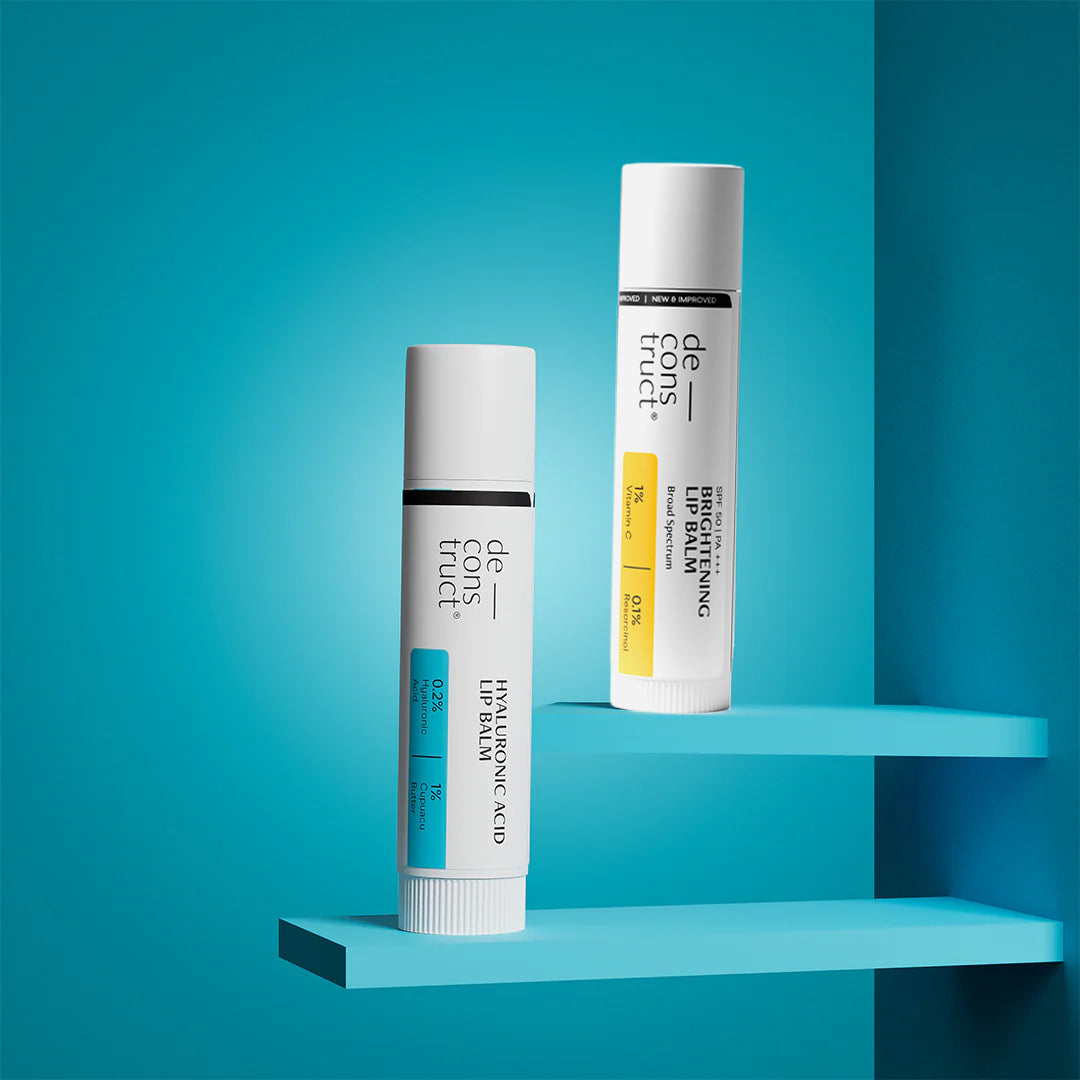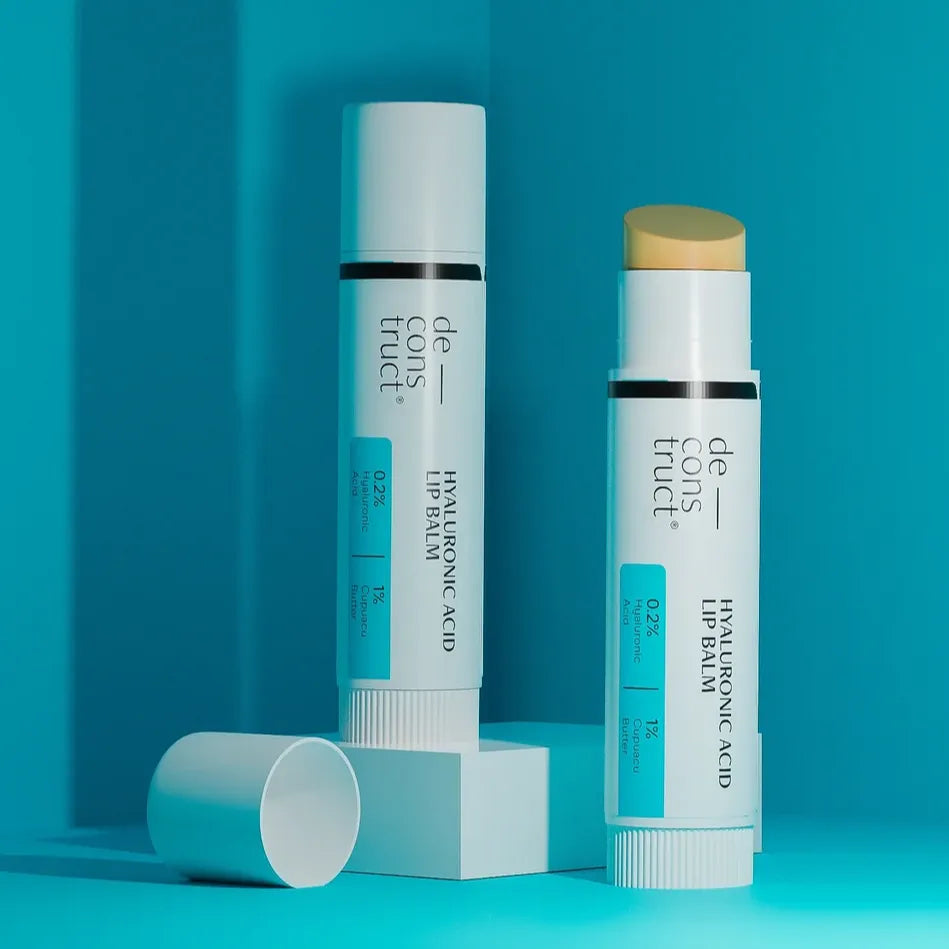Lips may be more prone to exposure than you realize. They are constantly exposed to stressors like UV, wind, dry air, and the movement of talking and eating. Unlike your lips, your skin has oil glands that prevent it from drying and chapping, making it necessary to use a lip balm every day.

Deconstruct — Hyaluronic Acid Lip Balm for Dry & Chapped Lips
Choosing the right lip balm will help you get rid of your chapped lips, reintroduce some moisture and protect them against sun damage.
In this guide, we will help you understand what lip balms are used for, talk about the different types of lip balms available, which lip balm to choose, and how to use lip balm on a daily basis. By the end of this guide, you will have the knowledge to begin making lip balm an essential part of your daily routine.
What Is the Use of Lip Balm?
A lip balm works by forming a protective barrier on your lips and helping lock in moisture. Your lips don’t have oil glands like the rest of your skin, so they’re prone to dryness, cracking, or chapping. A well‑chosen lip balm for dry lips can make a world of difference.
Key benefits:
-
The lip balm forms a layer on your lips to prevent water loss.
-
Regular use of a lip balm helps prevent dryness and cracking.
-
Lip balms with SPF and antioxidant support protect from UV rays and pollution.
-
Helps with chapped lips by calming and supporting recovery instead of just masking the problem.
Difference between lip balm, lip oil and lip mask
-
Lip balm is typically a semi‑solid formula you apply regularly, often day and night.
-
Lip oil has a light fluid texture, often adds shine plus hydration, and is more like a hybrid between lip treatment and gloss.
-
Lip mask is heavier, often used as an overnight treatment with intensive nourishment. So, if you’re asking, “Lip balm or lip mask? ”, the balm is your daily driver; the mask is the boost.
When to start using a lip balm
-
In dry or cold seasons, when indoor heating or cool air can strip moisture from your lips.
-
On sunny days, use a lip balm with SPF, especially when you’re outdoors.
-
Use it daily if you wear lipstick or matte finishes frequently, as they can dehydrate your lips. So yes, making “lip balm” part of your routine early is wise.
Which Type of Lip Balm Is Best?
There’s no “one size fits all” answer to this question. The best lip balm for you depends on your lip concerns.
|
Type |
Texture & feel |
Ideal for |
|
Butter/oil‑based lip balm |
Rich, soft, slightly glossy |
Lips that feel dry, rough or flaky |
|
Tinted lip balm |
Sheer colour with hydration |
If you want a hint of colour and care |
|
SPF lip balm |
Lightweight to medium, protective barrier |
Outdoor use, pigmented lips, daytime wear |
|
Medicated lip balm |
Often thicker, contains healing actives |
In case of very chapped, cracked, wounded lips |
Choosing based on your lip concern
-
If your lips feel dry and flaky, go for butter/oil‑based or a rich balm for dry lips.
-
If you’ve got sensitive or pigmented lips, look for fragrance‑free, gentle formulas, especially if you’ll be using a lip balm with SPF for protection and brightening.
-
If you’re outdoors frequently or wear strong lipstick, pick a lip balm with SPF.
For different seasons or climates:
-
In cold, windy weather use thicker butter/oil‑based balm to lock in moisture.
-
For sunny weather, use a lighter SPF balm to protect against damage.
Can I Use Lip Balm Daily?
The short answer is yes, and you probably should. Choose a lip balm that targets your lip concerns and has the right formula for your lips. Think of it as preventive care.
Why regular use is essential:
-
Your lips face environmental stress (sun, wind, indoor heating/cooling) just as your face does.
-
Using a lip balm daily helps prevent moisture loss rather than only repairing damage when the lips are already dry.
How often to reapply:
-
In the morning, apply it after brushing as your first lip care step.
-
After meals and drinks, since the lips are often wiped and brushed.
-
Before bed, especially if you have spent the day outdoors.
Common mistakes:
-
Overusing a medicated balm: these are great for specific issues but are not meant to be used as a daily-wear lip balm.
-
Licking lips before applying balm: saliva evaporates and can dry your lips further.
-
Using expired or fragranced balms: expired products may oxidise and may not provide any benefit; heavy fragrance can irritate lips.
Tips for a healthy daily lip care routine:
-
Exfoliate your lips weekly with a gentle scrub or a soft cloth to remove dead skin.
-
Apply a lip balm with SPF before stepping out into the sun to protect against UV damage.
-
Use a thicker balm or a lip mask at night to support repair while you sleep.
What Is the Best Lip Balm?
The “best lip balm” is the one that matches you and your daily habits. Here are some recommendations by category:
If you’re just starting, you might pick one lip balm for daytime (SPF) and one richer for night.
Additional Tips for Choosing and Using Lip Balm
-
Keep the lip balm out of direct heat, or it may melt and lose its texture.
-
If the texture changes (greasy or grainy) or the scent alters, know that it’s time to replace it. Most lip balms expire 12 months after opening.
If you’re someone who loves DIYs, here’s a natural lip balm recipe you can try! Mix 1 tbsp of beeswax with 1 tbsp of shea butter and a few drops of sweet almond oil – melt and pour into a container, but if you prefer purity, a packaged balm with tested SPF and brightening actives may be safer.
When you choose a balm, check if the packaging is recyclable or refillable – a small way to care for your lips and the planet.
Conclusion
Choosing the best lip balm isn’t about picking what’s trending; it’s about matching your lips’ concerns with the right formula and caring for them consistently. When you use a lip balm for dry lips daily and use it well, it protects, nourishes and enhances your smile.
Ready to explore your lip concern and find your ideal balm? Because healthy lips aren’t about the fanciest product but about consistent care with the right lip balm.
Frequently Asked Questions
Does lip balm make lips darker?
Only if the lip balm formula contains heavy pigments or if you repeatedly rely on low‑quality balms that lack protection will it result in further lip damage. The right lip balm for dry lips or pigmented lips will help improve tone over time.
Try the Deconstruct Brightening Lip Balm with SPF 30 which is a lightweight, non-tinted balm that protects against sun-induced pigmentation while brightening and evening out lip tone with consistent use.

Deconstruct — Brightening Tinted Lip Balm (1% Vitamin C + 0.1% Resorcinol, SPF 30 PA++)
Can I use lip balm under lipstick?
Yes! A thin layer of a good hydrating balm makes lipstick apply more smoothly and protects your lips. Just wait for a minute for the balm to settle.
Can I use the same balm all year round?
Yes, but your lips’ needs may change, so you might have to switch between a lip balm with SPF during the day/time and a richer balm for nights or cold months.





